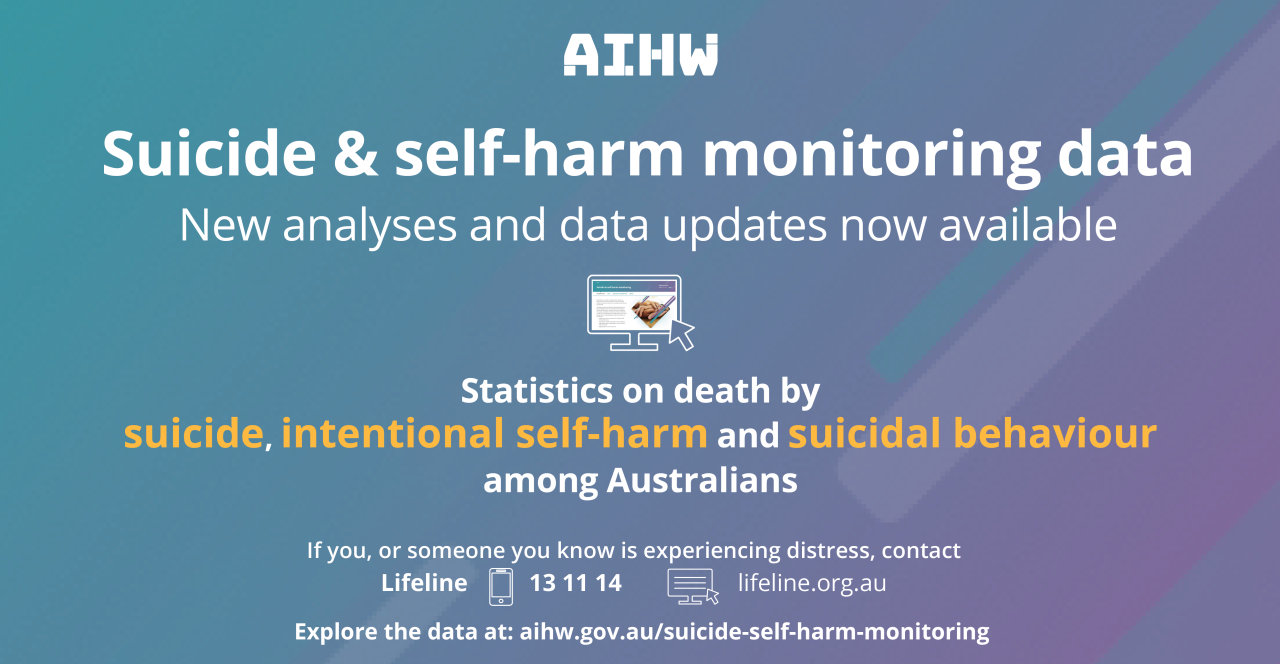New analyses and data updates to the AIHW’s suicide and self-harm monitoring system
The article was originally posted on LinkedIn by Matthew James, Deputy Chief Executive Officer
CONTENT WARNING: This article contains information some readers may find distressing as it refers to data about suicide and self-harm.
Today we have released new analyses and data updates to the AIHW’s National Suicide and Self-harm Monitoring (SSHM) Project.
The latest information is important in helping us build a more complete picture of suicidal and self-harming behaviours in Australia.
The AIHW acknowledges that every life lost to suicide is a tragedy and the impacts on family, friends and communities are profound. We acknowledge and pay our respects to those who have passed away, or been affected, by suicide.
So, what does the latest data tell us?
Hospitalisations
Firstly, there has been an increase in the intentional self-harm hospitalisations rate for females aged 0-14 years (from 41 per 100,000 population in 2019–20 to 70 in 2020–21). We know that intentional self-harm hospitalisations in this age group have been trending upwards for some time, increasing from 19 hospitalisations per 100,000 in 2008–09.
In 2020–21, there were nearly 30,000 hospitalisations due to intentional self-harm in Australia. Of these, two-thirds were female (66%, or over 19,800 hospitalisations in 2020-21 compared to 63%, over 18,000 hospitalisations in 2019-20).
Ambulance attendances
We have also released updated monthly snapshot data for suicidal and self-harm behaviours ambulance attendances. For females aged 0-24 years, self-injury attendances rose from 12.1 per 100,000 in September 2018 to 19.3 in September 2021.
Suicide attempt attendances have declined across Vic, Tas, NSW and Qld since 2020.
Other updates
In addition to these data updates, we commissioned The Australian National University’s Centre for Social Research and Methods (CSRM) to conduct further analysis on social and economic factors associated with suicide using the Multi-Agency Data Integration (MADIP) linked data asset, which uses deidentified data. This work produced a regression model including income level, income uncertainty, and unemployment associated with death by suicide.
It found:
- that the probability of dying by suicide is higher among those from the lowest income group compared to the highest income group.
- the odds of dying by suicide were higher among those experiencing longer periods of unemployment. Those who were unemployed for 4 years were estimated 2 times as likely to die by suicide compared to the employed group.
- the probability of dying by suicide is higher among those with higher variations in income (income uncertainty) compared to those with lower income uncertainty, regardless of overall income levels.
Finally, The University of Melbourne undertook an evaluation of the SSHM Project and System. These findings will inform future quality improvements of the System. Read the final report here.
Please visit our website for more information. There are interactive data visualisations and geospatial mapping to illustrate and explore the statistics as well as text to assist with the interpretation and clarification of the limitations of the data.
Full list of updates
· Final Evaluation of the Suicide & self-harm monitoring system
· Analysis: Longitudinal analysis of income uncertainty & suicide
· Data: Intentional self-harm hospitalisations 2020-21
· Data: Ambulance attendances - suicidal and self-harm behaviours
· A Primary Health Network consolation paper on data priorities for the AIHW Analyst Portal
Today’s updates form only one part of the SSHM Project and System which supports broader suicide prevention efforts happening nationally.
For crisis helplines, please visit our crisis support page.



